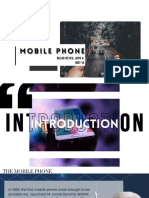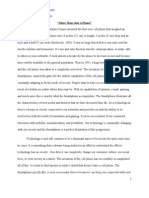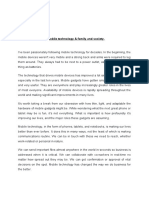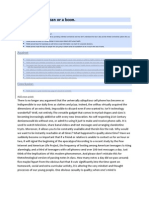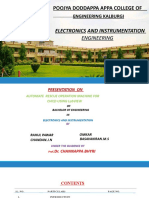Introduction
The mobile phone is stimulating one of the most important technological revolutions in human
History. This article first presents impacts, challenges, and predictions of mobile phone use. It
First indicates that the impact of the mobile phone on society has been predominantly positive
While the mobile phone has certain negative attributes. It then discusses multiple ways to
overcome mobile technology challenges (e.g., new radio technologies and specialized devices
optimized for medical, educational, or “Internet of things” applications). The authors predict
that, in The two or three more generations, mobile phones use will have exciting advances to
achieve The full benefits, especially in the area of healthcare, education, industry, daily life,
learning, and Collaborations, which will be more effective, productive, and creative.
� Development
The mobile phone is stimulating one of the most important technological revolutions in human
history. This statement is not hyperbole.There are more mobile phones in use today than there
are people, but Measuring quantity alone trivializes the importance of the mobile Phone to
those who rely on it. Surveys have shown that people would Rather eat less than give up their
mobile phone. People who forget Their phone at home will return to retrieve it but would elect
to move on without their wallet. The U.S. Supreme Court has ruled that a Mobile phone is na
integral part of a person, na extension of her or his Personality.
And yet, the mobile phone revolution is just beginning. Simple feature phones” have
contributed to lifting over a billion people out Of severe poverty in Africa. Simple add-ons are
bringing professional Medical treatment to remote villages in Mexico. In India, e-commerceIs
raising the standard of living for millions. In developed countries, we Are only beginning to
understand how much smartphones will improve Our lives.
� IMPACTS
By far, the greatest contribution to society of the mobile phone is in improved productivity.
People act more efficiently when they are cominected, especially when they are connected
whenever, wherever, and to whomever they wish. Beyond that, the mobile phone is na
invaluable tool that can entertain, educate, improve safety, and add convenience to our lives.As
with every disruptive technology, mobile phones have negative attributes as well. Perhaps we
first realized this in 1989 when Mobile phones first rang in movie theaters. While some may
have Been annoyed or angered, we were dismayed.
Our abiding belief in The potential of the mobile phone blinded us to the ways in which it Could
be antisocial. And, of course, ringing in a movie theater or comcert hall was not the only
annoyance.The first commercial portable mobile phones became available in October 1983.
Why did it take so long to discover their antisocial Aspects? Initially, most mobile phones were
wired into automobiles.The only handheld units—and we use the word “handheld” loosely—
Were Motorola DynaTACs, which weighed over a kilogram and were,For obvious reasons,
called “the brick.” People were unlikely to carry The DynaTAC into a concert hall.
Since that cell phone sold for $4,000, the equivalent of about $10,000 today, chances of even
Encountering one were slim. In 1989, Motorola introduced the MicroTAC, a flip phone which by
modern standards was large, but at 12.3 oz was small enough to fit into a coat pocket. The
MicroTAC was Affordable enough to become popular.In the early days, the cost of a call was
high: 50 cents a minute.In the U.S., customers paid for incoming calls, making them reluctant
to give out their cell phone number. As prices for service fell, especially after the assignment of
more channels in the early 1990s,Incoming calls and their related annoying alerts became
more prominent. Consequently, smaller handheld units and the slow reduction of Usage
charges started to change people’s expectations—cellphones Were becoming even more useful
than fixed phones. We started to See—or rather, hear—phones in movie theaters and concert
halls.The mobile phone alone does not make people rude.
Polite people learned to turn their ringers off in the concert hall and to speak in Muted voices
in crowded areas. In Japan, for example, using a mobile Phone in a railway car will earn a sharp
rebuke from the conductor.Society ultimately learns how to accommodate disruptive
technology,So we rarely hear phones ring at the movies today
� CHALLENGES
We are still in the early days of mobile phone development. Only a Small fraction of the mobile
phone’s potential has been unlocked.Services, especially Internet access, are too costly, as are
the phones Themselves. Smartphones try to do all things for all people but do,None optimally.
Mobile phones are designed as mass-market commodities without regard for the fact that
people are unique and that Different people benefit from phones designed for their unique
Needs.Each of these deficiencies is being addressed in our society in the Following ways:
• New radio technologies are increasing the capacity of existing Systems and reducing service
costs.
• Specialized devices optimized for medical, educational, or “Internet of things” applications
are appearing each day.
• Applications are starting to appear that promise to revolutionize Medicine, education, and
business.
• People are starting to collaborate in ways that were not even dreamt About 10 years ago; the
capacity of mobile-phone-enabled collaboration to topple governments has already been
demonstrated.
PREDICTIONS
We predict a world in which the mobile phone makes the most Advanced medical technology
available to all, as it helps solve the Dilemma of a healthcare system focused on curing diseases
rather than Preventing them. We predict a society in which mobile-phone-enhanced education
Occurs 24 hr a day everywhere—not just in the classroom; in which Students are educated in
stimulating ways; in which the knowledge of The world is available to all. We predict na
industrial society in which hierarchical organizations give way to collaborative self-organized
entities in continuous Communications with one another. We predict a technological revolution
in which the wireless technologies we espouse become either invisible, transparent, or
intuitive,With the sole function of serving us as they make our lives better, and Hopefully
simpler. We predict a new education paradigm in which students wirelessly connected to the
Internet learn in the real world, and where the Role of the teacher is elevated to counseling
and customizing the education of students. Wireless technology, the mobile phone, and all its
derivatives will Not be the sole catalyst for energizing these revolutionary advancements. Nor
will wireless technology solve the social, legal, and regulatory barriers that must be overcome.
It is our fervent hope, however, That the promise of a technological solution is so compelling
that the,Bureaucrats and bigots will fall by the wayside and lawyers will actually facilitate
progress. We further point out that the first phase of The wireless revolution took more than a
human generation to Evolve. It will take two or three more generations to achieve the full
Benefits we predict. But progress, as you will clearly observe in this Journal, is already
happening; it will be continuous and relentless, and There will be incremental benefits all along
the way.Some readers may find our predictions overly optimistic.
� Coclusion
The polysemy of mobile phone technology has a complex, co-configuring effect on its user.
Encompassing all public And private relationships at all points in time, the mobile has far-
reaching consequences for the self in everyday life. Polysemy leads to contradictory
developments in use. Convenient instantaneous communication is accompanied By perpetual
consciousness of contactability. The ease with which people can now communicate underlies
anxiety Of not being contacted. Raised awareness of the proximity of friends, relatives,
employers, services and bullies Can subsequently influence the mental state of the user. The
mobile can increase the metabolic rate of everyday Life whilst simultaneously fragmenting daily
experience; it can liberate and enhance individual self experimentation Whilst constricting and
complicating identity management. The popularity of quick, easy and private text messaging
Has ironically been identified as causing ambiguity and anxiety or even provoking new kinds of
group reflection on Communicative processes.


